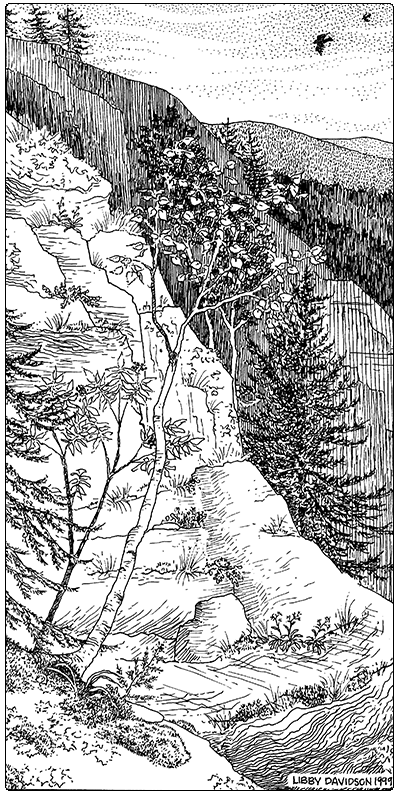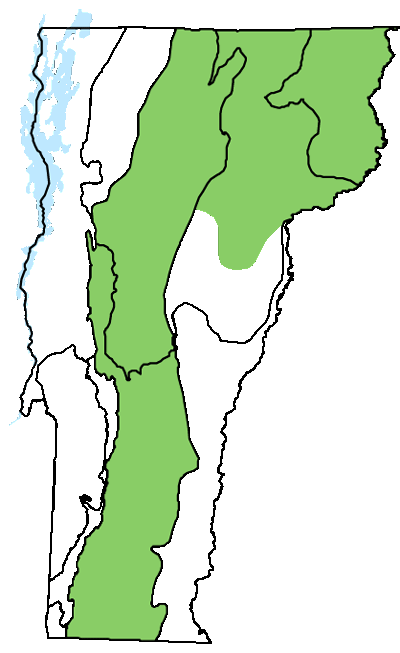Ecology and Physical Setting 
Boreal Acidic Cliffs are found on very steep slopes or vertical faces in the colder parts of the state and region, either at high elevations (above 2,000 feet or so), or in cold valleys at lower elevations, where Spruce-Fir Forests dominate. The bedrock making up these cliffs yields little in the way of important plant nutrients, either because it is acidic or because it does not weather easily, or because of a combination of these factors. Granite, quartzite, and acidic schist are typical rock types for this community. Soil accumulates in crevices and on ledges, but soils are shallow and vulnerable to erosion.
Surprisingly, cliffs that are generally acidic can sometimes support calcium-loving plant species, particularly in cracks with water seepage (Bailey 2013). Even in slow-weathering rock, this water can collect and concentrate minerals. Also, many so-called acidic rocks can contain very thin veins of calcium-rich rock. If these veins are exposed on the cliff face, or if seepage water has passed through these veins, they can create enriched growing conditions.
Vegetation
Boreal Acidic Cliffs are often surrounded by Spruce-Fir Forests, and therefore have many of the species associated with that forest type. Tree cover is very sparse, though, generally under 25 percent, and overall plant diversity is low. Small red spruce, heart-leaved paper birch, and American mountain ash may be found in rock crevices, but these rarely reach heights over 15 feet. Bush-honeysuckle is a low shrub that can be locally abundant in rock crevices where small amounts of soil have accumulated. Lichens can be abundant, sometimes covering nearly every square inch of exposed rock. Fragrant fern is a rare plant that is often found on these cliffs even though it is always associated with a source of calcium. It grows in cracks, where groundwater seepage supplies this calcium.
Wildlife Habitat
Boreal Acidic Cliffs provide nesting sites for three distinctly different birds. Peregrine falcon—an uncommon species in Vermont and one of world’s fastest birds, reaching speeds of 200 miles per hour when diving to strike prey—nests directly on exposed rock ledges of the cliffs. Common raven, a species that was once extirpated from Vermont but is now common, builds deep stick nests on cliff ledges. And turkey vulture—a bird we see most soaring high overhead and searching for carrion with its keen sense of smell—is a highly secretive nester, using crevices in cliff faces and other sheltered and secluded places.
Related Communities
- Boreal Calcareous Cliffs are generally much richer in species than Boreal Acidic Cliffs. In addition, they have a number of specialized rare plants.
- Temperate Acidic Cliffs lack species such as red spruce and heart-leaved paper birch, and instead support warmer climate species such as eastern hemlock and red oak.
- Boreal Outcrops are often found in association with Boreal Acidic Cliffs. The outcrop is at the top, or brow, of the cliff. Outcrops have slopes that are less than 60 degrees. In both communities, vegetation is sparse, though the reasons change with slope. Outcrops generally experience higher winds, more sunlight, and deeper snow packs in winter.
Conservation Status and Management Considerations
Most large Boreal Acidic Cliffs are protected on conserved lands. Even when conserved, cliffs—and their plants and animals—are vulnerable to disturbance and erosion. The greatest threats come from rock climbing, which can result in damage to vegetation, and the erosion of soil accumulated over millennia in crevices and on ledges. Many of Vermont’s cliffs are closed to recreational activities during the peregrine falcon nesting season.
Distribution/Abundance
Boreal Acidic Cliffs are common in Vermont, though large examples are few. They are found in areas of acidic bedrock in the Northern Green Mountains, Northern Vermont Piedmont, Northeastern Highlands, and Southern Green Mountains.
Characteristic Plants
Trees
Red spruce – Picea rubens
Balsam fir – Abies balsamea
Heart-leaved paper birch – Betula cordifolia
American mountain ash – Sorbus americana
Red maple – Acer rubrum
Shrubs
Bush-honeysuckle – Diervilla lonicera
Swamp red currant – Ribes triste
Skunk currant – Ribes glandulosum
Low sweet blueberry – Vaccinium angustifolium
Velvetleaf blueberry – Vaccinium myrtilloides
Herbs
Harebell – Campanula rotundifolia
Appalachian polypody – Polypodium appalachianum
Three-toothed cinquefoil – Sibbaldia tridentata
Poverty grass – Danthonia spicata
Hay-scented fern – Dennstaedtia punctilobula
Hairgrass – Deschampsia flexuosa
Brownish sedge – Carex brunnescens
Long beech fern – Phegopteris connectilis
Rare and Uncommon Species
Fragrant fern – Dryopteris fragrans
Deer-hair sedge – Trichophorum cespitosum
Steller’s cliffbrake – Cryptogramma stelleri
Alpine sweet grass – Anthoxanthum monticola
Appalachian firmoss – Huperzia appressa
Highland rush – Juncus trifidus
Boott’s rattlesnake-root – Nabalus boottii
Rand’s mountain goldenrod – Solidago randii
Associated Animals
Common raven – Corvus corax
Turkey vulture – Cathartes aura
Rare and Uncommon Animals
Peregrine falcon – Falco peregrinus
Places to Visit
Groton State Forest, Groton, Marshfield and Peacham, Vermont Department of Forests, Parks, and Recreation (VDFPR)
Wheeler Mountain, Sutton, Willoughby State Forest, VDFPR
White Rocks, Wallingford, Green Mountain National Forest
